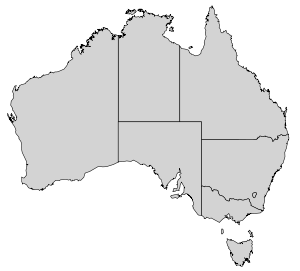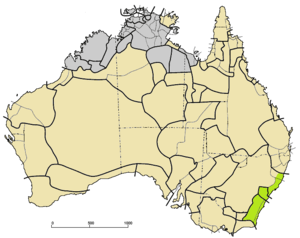Yuin–Kuric languages
| Yuin–Kuric | |
|---|---|
| (geographic) | |
| Geographic distribution: | New South Wales, ACT, and SE Queensland, Australia |
| Linguistic classification: |
|
| Subdivisions: |
|
| Glottolog: | yuin1243[1] |
|
Yuin–Kuric languages (green) among other Pama–Nyungan (tan). From southwest to northeast, the three groups are Yuin, Yora, and Kuri. | |
The Yuin–Kuric languages are a family of mainly extinct indigenous Australian languages that existed in the south east of Australia.
They belong in the Pama–Nyungan family.[2] These languages are divided into the Yuin, Kuri, and Yora groups, although exact classifications vary between researchers. Yuin–Kuric languages were spoken by the original inhabitants of what are now the cities of Sydney and Canberra. Most are now extinct.
The koala is named from the word gula for the animal in Dharuk,[3] a Yuin–Kuri language within the Yora group, and the same word occurs in other Yuin–Kuri languages, such as Gundungurra,[4] within the Yuin group.
Languages
The constituent languages are groups are arranged from southeast to northwest:
Yuin group
The Yuin (southern) group includes:
- The extinct[5] Tharawal languages spoken along the South Coast of New South Wales, including Thawa, Dyirringany, Thurga, Tharawal, and possibly Gweagal.
- Nyamudy language spoken by people around Canberra
- Ngarigo (Ngarigu) spoken by the Ngarigo people
- Ngunnawal, also known as Gundungurra (Gundungura, Gudungura, or Gandangara), spoken by the Ngunnawal people and Gandangara people in inland south-eastern New South Wales in the now Yass region.
Yora group

some Yuin-Kuric languages
The Yora or Iyora (central) group is accepted by Dixon.[6]
- Dharug, an extinct language[5] which attempts are being made to revive.[7]
- Darkinjung, an extinct language.[5]
They were spoken in the region of Sydney.
Kuri group
The Kuri (northern) group has been reduced to its southernmost languages:
- Worimi languages: Worimi (Worimi, Katthang, Birrpayi), Awabakal
- Dunghutti language
Languages once classified as Kuric include Yugambal, Yuggarabul (Yuggera), and Nganyaywana (Anaiwan) further north.
Comparison
Jeremy Steele's partial reconstruction of the Sydney language[8] includes a comparison of pronouns in several Yuin–Kuric languages. The following partial and simplified version shows some of the similarities and differences across the family:
| Language | Group | I | You (singular) | He | We two (inclusive) | We two (exclusive) | We all (inclusive) |
|---|---|---|---|---|---|---|---|
| Gundungurra | Yuin | gula-ngGa, gula-nga | gulandyi | dhanaladhu | gulanga | gulangala(ng) | gulanyan, gulambanya(n) |
| Tharawal | Yuin | ngayagang(ga) | nyindigang | namarang | ngulgang | ngangaling(ga) | nyulgang(ga) |
| Awabakal | Kuri | ngaduwa | nginduwa | nyuwuwa | bali | balinuwa | ngiyin |
| Darkinjung | Yora | ngaya | nyindi, ngindi | nuwa | ngaliya | ngungaliya | ngiyang |
| Dharug | Yora | ngaya | nyindi, ngindi | nanu | ngali | — | — |
References
- ↑ Hammarström, Harald; Forkel, Robert; Haspelmath, Martin; Bank, Sebastian, eds. (2016). "Yuin–Kuri". Glottolog 2.7. Jena: Max Planck Institute for the Science of Human History.
- ↑ AIATSIS Language and Peoples Thesaurus Archived 9 October 2009 at the Wayback Machine., accessed 23 Jan 2010.
- ↑ Dixon, R.M.W.; Moore, Bruce; Ramson, W. S.; Thomas, Mandy (2006). Australian Aboriginal Words in English: Their Origin and Meaning (2nd ed.). South Melbourne: Oxford University Press. p. 64. ISBN 0-19-554073-5.
- ↑ Eugene Stockton, Blue Mountains Dreaming: The Aboriginal Heritage, Three Sisters Productions, 1993, p. 88, ISBN 0-646-14883-4.
- 1 2 3 Christopher Moseley, Encyclopedia of the World's Endangered Languages, Routledge, 2007, ISBN 0-7007-1197-X.
- ↑ Dixon, R. M. W. (2002). Australian Languages: Their Nature and Development. Cambridge University Press. p. xxxv.
- ↑ See the William Dawes web site, accessed 23 Jan 2010.
- ↑ Jeremy Steele's Master of Arts thesis, 2005
